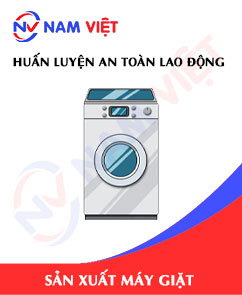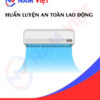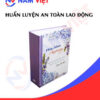Occupational Safety Training For Washing Machine Manufacturing
99,000 ₫
Note: The above price is calculated for one person, the price may fluctuate depending on the number of trainees participating in the course and the movement of the market. For more accurate pricing support, please refer to the quotation or contact directly with our consultants.
Occupational safety is an important issue in washing machine manufacturing factories and needs to be addressed promptly to ensure the health and safety of workers, as well as to enhance the reputation of enterprises. The Occupational Safety Training course is one of the effective solutions to raise awareness about preventing occupational accidents for workers participating in washing machine manufacturing.
Table of Contents
Toggle1. Overview of Washing Machines
a. What is a Washing Machine?
A washing machine is an electronic device used to wash clothes, bed linens, pillows, and other items. Washing machines are typically equipped with a water tub and a rotating drum to wash clothes in water.
Modern washing machines often feature advanced functions such as sensors, delicate wash cycles, wool wash, color wash, and other settings for sensitive materials.
Washing machines can operate using cold or hot water and can use different types of detergents depending on the material and dirtiness of the clothes.

b. Types of Machinery for Washing Machine Production
The machinery used in washing machine production includes:
- Metal cutting and bending machines: These machines are used to cut and bend metal sheets into smaller parts of the washing machine such as the outer casing and assembly components.
- Plastic molding machines: These machines are used to mold plastic parts of the washing machine, such as the lid.
- Welding machines: These are used to weld metal parts of the washing machine together, such as the drum casing.
- Paint spraying machines: These are used to apply protective paint layers on the surface of the washing machine, enhancing durability and appearance.
- Motor manufacturing machines: These are used to produce the motors for the washing machines.
- Assembly machines: These are used to assemble all parts of the washing machine into a finished product.
- Quality control machines: These are used to test the product to ensure the washing machine functions properly before leaving the factory.
Depending on the production technology, manufacturers may use different machinery to create their products.

c. Washing Machine Manufacturers in Vietnam
There are many well-known washing machine brands globally and in Vietnam, including:
- Samsung: One of the most famous brands in electronics and home appliances, including washing machines.
- LG: Another well-known electronics and home appliance brand, offering various washing machine models with different features.
- Panasonic: A renowned brand in electronics and household appliances, producing multiple types of washing machines.
- Electrolux: A Swedish brand specializing in home appliances, offering washing machines with advanced features.
- Toshiba: A well-known electronics and home appliance brand, producing washing machines in various styles and functions.
- Hitachi: A Japanese brand, producing washing machines with advanced features and elegant designs.
- Midea: A Chinese brand offering washing machines in multiple designs and features.
- Beko: A Turkish brand providing washing machines with smart functions and energy efficiency.
- Sharp: A Japanese brand producing washing machines with stylish designs and advanced functions.
- Bosch: A German brand offering washing machines with high-end features and reliable quality.

d. Specific Jobs in Washing Machine Factories
Group 1
- CEO, Deputy CEO, Department Heads in washing machine factories.
Group 2
- Safety officers: managing safety in the factory, designing safety procedures, monitoring, and ensuring employees follow safe working procedures.
Group 3
- Product quality control: Employees ensure that all products meet quality and safety standards.
- Component assembly: Workers assemble components to create finished products, including controllers, motors, filters, water nozzles, and other parts.
- Product functionality testing: Products are tested to ensure proper operation and compliance with technical requirements before shipping.
- Product packaging: After quality control, products are packaged and prepared for shipment to dealers or retail stores.
- Repair and maintenance: Technicians are responsible for repairing and maintaining washing machines in case of malfunctions or customer requests.
Group 4
- Office work, service, sales, marketing.
- Production management, quality management, human resources management, materials management, financial and accounting management.
- Product design and research: Engineers and designers create new design ideas for washing machine products.

2. Overview of Occupational Safety Training for Washing Machine Production
In this article, we focus on issues related to Group 3 because Group 3 directly participates in the production process and faces the highest occupational safety risks. Refer to other groups here.
a. What is Group 3 Occupational Safety Training?
- Group 3 occupational safety training is a series of sessions that equip workers with knowledge on preventing workplace accidents.
- This training helps workers recognize hazards, prevent risks, and reduce the likelihood of workplace accidents during operations.
REGISTER FOR OCCUPATIONAL SAFETY TRAINING SERVICE
b. Training Duration
Initial safety training duration
- Total training duration is at least 24 hours, including assessment time.
- 8 hours of theory on safety policies, labor laws, and hygiene.
- 8 hours of theory on basic occupational safety and hygiene knowledge.
- 4 hours of theory on specialized training content.
- 2 hours of practical training on specialized content.
- 2 hours of theory assessment at the end of the course.
The training center will divide the schedule into multiple sessions depending on workers’ availability. Typically, there are 6 training sessions over 3 days, assuming the company can arrange continuous learning time.
Periodic safety training duration
- Before the occupational safety card expires, workers wishing to renew must undergo periodic occupational safety training, with a periodic training duration of at least 50% of the initial training duration.
Explanation: The total duration of periodic occupational safety training is at least 12 hours, including assessment time. Upon completing the periodic training and passing the test, workers will have their occupational safety card renewed.
c. Training Content
| No. | TRAINING CONTENT | TRAINING DURATION (HOURS) | |||
| Total | Including | ||||
| Theory | Practical | Assessment | |||
| I | Safety Policies, Laws, and Occupational Hygiene | 8 | 8 | 0 | 0 |
| 1 | Overview of legal documents and regulations on occupational safety and hygiene. | 6 | 6 | ||
| 2 | Standards and technical regulations on occupational safety and hygiene. | 1 | 1 | ||
| 3 | Specific regulations from state authorities on occupational safety and hygiene when constructing, expanding, or renovating production facilities and managing machines, equipment, materials, or substances with strict safety and hygiene requirements. | 1 | 1 | ||
| II | Basic Knowledge of Occupational Safety and Hygiene | 8 | 8 | 0 | 0 |
| 1 | Basic knowledge of hazards and harmful factors in the workplace. | 4 | 4 | ||
| 2 | Methods to improve working conditions. | 1 | 1 | ||
| 3 | Safety culture in production and business. | 1 | 1 | ||
| 4 | Rights and obligations of employers and employees; safety policies and regimes; functions and responsibilities of safety networks and personnel. | 1 | 1 | ||
| 5 | Safety and hygiene rules, signs, instructions, proper use of safety equipment and personal protective equipment; first aid skills and occupational disease prevention. | 1 | 1 | ||
| III | Specialized Training Content | 6 | 4 | 2 | 0 |
| Comprehensive knowledge of machines, equipment, hazardous substances; risk analysis, evaluation, and management; safe working procedures with machines, equipment, and substances requiring strict safety and hygiene standards. | 6 | 4 | 2 | ||
| IV | End-of-course Safety Training Assessment | 2 | 2 | 0 | 0 |
| Total | 24 | 22 | 2 | ||
See more training content for all 6 groups
d. Occupational Safety Card
After completing the occupational safety training and passing the assessment, workers will be issued an occupational safety card (commonly referred to as a Group 3 occupational safety certificate).
The Group 3 card displays the worker’s full name, date of birth, job title, and working environment. It also includes training duration, red seal, and signature confirming course completion.
According to Clause 2 of Article 24 of Decree 44/2016/ND-CP, there are two cases:
- If there is a labor contract between the employer and the worker, the employer must sign, stamp, and validate the safety card after the worker completes the training and passes the assessment.
- If the worker is freelance or seasonal with no labor contract, the training unit must sign, stamp, and validate the safety card after the worker completes the training and passes the assessment.

3. Identifying Hazards Affecting Workers in Washing Machine Manufacturing
During the washing machine manufacturing process, workers may be exposed to various hazards, including:
- Electrical hazards: Employees often work with electrical components and circuits during manufacturing. If not used and maintained properly, electrical voltage can cause accidents such as electric shock or fire/explosion.
- Chemical hazards: Using chemicals for painting and surface treatment also poses health risks to washing machine manufacturing staff.
- Temperature hazards: The manufacturing process may involve high or low temperatures, making workers susceptible to respiratory problems, atmospheric issues, and burns.
- Occupational accidents: Employees may experience accidents while operating machinery, including cuts, punctures, or being trapped in equipment, pipes, springs, etc.

4. Common Occupational Accidents for Workers in Washing Machine Manufacturing
Common occupational accidents during washing machine manufacturing include:
- Cutting and injury accidents: Washing machine manufacturing machinery has many sharp edges and cutting tools, so the risk of cuts and injuries is very high.
- Impact and crushing accidents: During manufacturing, machinery operates continuously, increasing the risk of impacts or crushing injuries.
- Chemical poisoning: Chemicals such as sulfuric acid, sodium hydroxide, formaldehyde, benzene, toluene, solvents, glue, plastics, preservatives, detergents, and other additives are used in washing machine manufacturing. Without proper protective equipment, the risk of chemical poisoning is very high.
- Fire and explosion: Washing machine manufacturing machines usually operate on electricity. Improper maintenance or use can cause fire or explosion accidents.
- Environmental pollution: Washing machine manufacturing can generate wastewater, dust, emissions, and solid waste, potentially causing environmental pollution and affecting the health of workers and surrounding communities.

5. Safety Measures When Participating in Washing Machine Manufacturing
Safety measures when participating in washing machine manufacturing include:
- Ensure full personal protective equipment (PPE) such as helmets, safety glasses, gloves, safety shoes, masks, and protective clothing meeting standards.
- Provide training and instructions on proper use of protective equipment.
- Regularly inspect, maintain, and repair machinery to ensure safety and prevent accidents.
- Implement fire and explosion prevention measures, including regular checks of electrical systems, ventilation systems, and proper oil/grease inspections.
- Install electrical safety measures, including lightning protection and overload protection.
- Apply motor safety measures, including shock-absorbing systems and overload protection.
- Apply chemical safety measures, including correct use of chemicals and avoiding skin and eye contact.
- Apply noise safety measures, including using hearing protection and minimizing noise during manufacturing.
- Ensure hygiene and food safety, including keeping manufacturing areas clean and storing products properly.
- Periodically conduct workplace environment monitoring in factories, collect and analyze harmful factors for workers, and adjust to reduce hazards to prevent occupational diseases.
6. Benefits of Occupational Safety Training in Washing Machine Manufacturing
An Toan Nam Viet provides your business with the following benefits after completing occupational safety training courses in accordance with Decree 44/2016/ND-CP on occupational safety and hygiene for companies, factories, and enterprises:
- Workers can identify potential hazards of occupational accidents and take preventive measures to avoid accidents.
- Your business can establish risk prevention measures in manufacturing, operation, and maintenance processes.
- Minimize costs associated with potential safety hazards in labor.
- Continuous manufacturing helps increase labor productivity and product quality.
- Compliance with occupational safety laws reduces legal risks.
- Enhances credibility and professionalism, elevating your company’s brand.
Nam Viet’s training courses are a solution to prevent external factors from endangering individuals, helping them avoid injuries or, in severe cases, death.
REGISTER FOR OCCUPATIONAL SAFETY TRAINING SERVICE
7. Customer Feedback After Completing Occupational Safety Training in Washing Machine Manufacturing
An Toan Nam Viet has many years of experience accompanying businesses in Vietnam in general and in southern provinces in particular. This responsibility is extremely valuable, which is why An Toan Nam Viet’s occupational safety training is increasingly professional. The motivation for An Toan Nam Viet’s growth comes from both positive feedback and constructive suggestions from our business partners. Below are feedbacks from partners we have served.
Bac Nam E&C Investment and Construction Joint Stock Company
“The first time using An Toan Nam Viet’s service, I was surprised by the 24/7 support from the consulting team. Class organization was fast and convenient for our company. Thank you very much for Nam Viet’s service!”
See more customer interviews after using An Toan Nam Viet services
8. An Toan Nam Viet’s Capacity in Occupational Safety Training
An Toan Nam Viet is a reputable and high-quality occupational safety training center in Vietnam. Our courses are conducted continuously at factories, workshops, or construction sites nationwide (63 provinces in Vietnam).
REGISTER FOR OCCUPATIONAL SAFETY TRAINING SERVICE
Occupational safety training license
- An Toan Nam Viet has been inspected and certified by the Safety Department of Ministry of Labor – Invalids and Social Affairs and received a certificate of eligibility for occupational safety and hygiene training. This further strengthens our capacity in occupational safety training.

Materials and lectures
- Before being applied in occupational safety courses, training materials are reviewed to ensure accuracy and effectiveness.
- Our lecturers use teaching methods standardized by An Toan Nam Viet, developed by experts in occupational safety and hygiene training to maximize learning efficiency.
Facilities
- Controlling classroom factors affecting training improves teaching efficiency and knowledge absorption.
- Our training facilities provide spacious classrooms meeting standards for area, lighting, and equipment.
9. Nationwide Reputable and High-Quality Occupational Safety Training Center
At An Toan Nam Viet, we prioritize occupational safety training. Teaching workers to protect themselves is contributing to nation building.
To ensure effective training, we meticulously prepare all aspects, from teaching tools, equipment, curriculum, materials, sound, and lighting.
Our occupational safety lecturers are experts with many years of experience and research on hazard identification and prevention in all sectors.
Lectures are practical, engaging, and easy to understand. Knowledge is always aligned with Decree 44/2016/ND-CP.
Workers learn preventive measures and self-protection techniques, applying them effectively in real work.
Our training center is proud to provide professional and reputable occupational safety training with advantages:
- Competitive training costs while maintaining quality.
- Flexible training schedule according to company manufacturing activities.
- Fast, legally compliant certification procedures.
- Experienced lecturers in the field.
- Controlled classrooms improve teaching efficiency and knowledge absorption.
- Lectures tailored to company occupational safety needs.
- An Toan Nam Viet works diligently and professionally to support customers accurately and quickly.

10. Additional Reference Materials for Occupational Safety Training in Washing Machine Manufacturing
- Occupational safety training materials set
- Washing machine manufacturing safety materials
- Occupational safety test set
- Occupational safety training curriculum for washing machine manufacturing
- Washing machine manufacturing occupational safety quiz
1 review for Occupational Safety Training For Washing Machine Manufacturing
No comments yet















namchinh.haiphong341
Dịch vụ huấn luyện an toàn lao động rất tốt nhé!